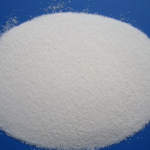Sodium Benzenesulfonate
Synonyms: Benzene sulfonic acid sodium salt, sodium benzene sulphonate, benzene sulfonic acid sodium salt, sodium benzene sulphonate
Technical index: 98%
CAS No.: 515-42-4
EINECS: 208-198-2
MF: C6H5NaO3S
MW: 180.16
S.F.
Appearance: White crystal or powder,the temperature 70 ° C, 25 ° C for 25g/100ml water solubility in aqueous solution by chopped decomposition. Heat can be dissolved in dilute ethanol.
Purpose:
Sulfonic acid and its salts present in organic dyes provide useful function of water solubility and or improve the washfastness of dyes due to their capabiltity of binding more tightly to the fabric. They are widely used in the detergent industry. Alkylbenzene sulfonic acid is the largest-volume synthetic surfactant because of its relatively low cost, good performance, the fact that it can be dried to a stable powder and the biodegradable environmental friendliness. Sulfonate cleaners do not form an insoluble precipitates in hard water. Sulfonic acid salts and esters are intermediates widely used in organic synthesis and particularly phenolic compounds and cation exchange resins. They are synthetic intermediates for a number of biologically active compounds and pharmaceutical candidates such as sulfa drugs. Benzenesulfonic acid consumption is linked mostly to phenol and resorcinol production with sodium hydroxide. It is used as a catalyst for dehydration and used in solidifying resins. It is a base material for electroplating solutions. Benzenesulfonic acid, or a derivative thereof, is used as a synthetic intermediate for a number of chemical families of pharmaceuticals, pesticides, dyes, pigments, fluorescent brighteners, and other organic compounds. Commercially, benzenesulfonic acid sodium salt is more common due to high deliquescence of the base material.
Packing: 40Kg/drum.
Q: Substance use?
It is used in the synthesis of new pesticides and insecticides, and it can also be used in dye intermediates, detergent auxiliaries and foundry industries and slurry conditioner for chemical industry and synthetic detergents. And it can play the following four functions: First, it can reduce the viscosity of the slurry, improve the fluidity of the slurry, make powder spraying more convenient, to reduce energy consumption, and thus increase production capacity. Second, it can increase the moisture content of the aqueous washing powder by 2-4%, reducing the cost. Third, it can promote the hydration of pentasodium in washing powder, improve the anti-caking performance of washing powder, which can improve product quality. Fourth, it can reduce the loss of fine powder in the tail gas of the powder spraying tower, reduce pollution and increase production.
Q: Incident response?
Skin contact: Take off the contaminated clothes immediately, and wash the contaminated parts with water, and the clothes can be reused after washing. Seek medical attention if skin irritation occurs.
Eye Contact: Rinse carefully with water for several minutes. If wearing contact lenses and it is easy to remove, remove contact lenses and continue rinsing. If eye irritation persists, seek medical attention immediately.
Inhalation: Remove the patient to fresh air and keep comfortable position for breathing.
Q: Safe storage?
Store in a well-ventilated place. Keep container tightly closed. Storage must be locked.
Disposal considerations: Dispose of contents container in accordance with local regulations.
Health Hazards: It may Cause skin irritation, serious eye irritation and respiratory irritation.
